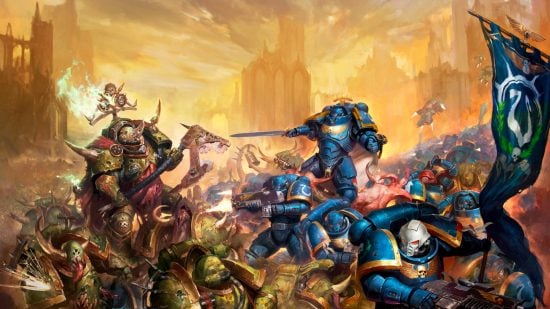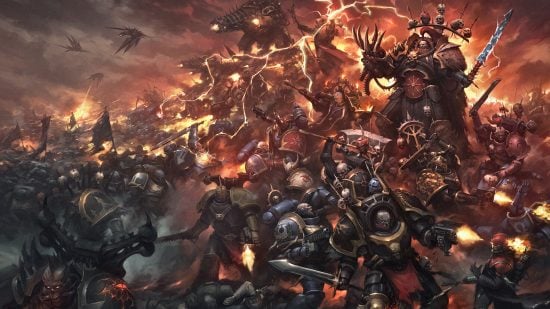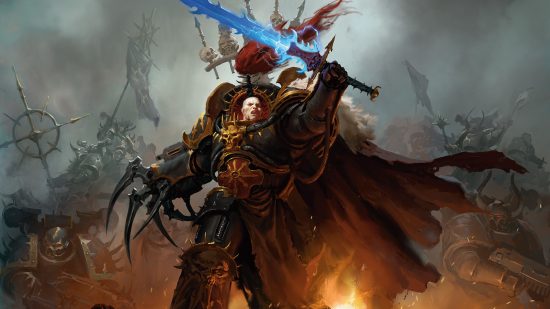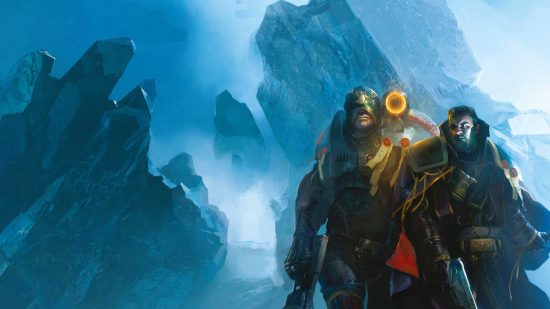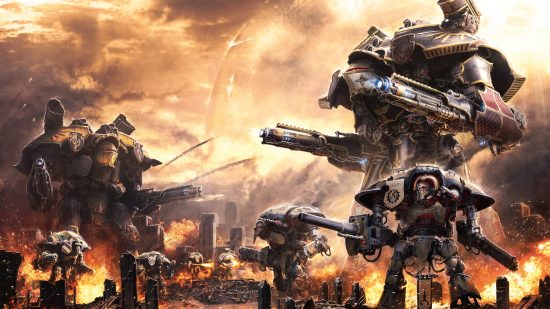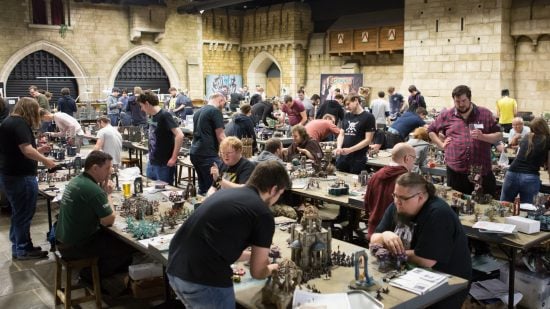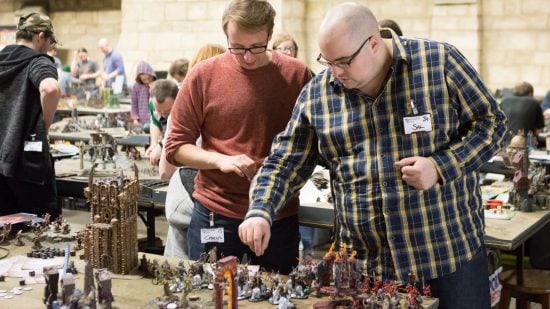There are loads of ways to discover Warhammer 40,000 – you might have heard the buzz about Henry Cavill’s next acting role, enjoyed blasting mutants in the videogame Darktide, picked up a novel or comic in a bookstore, or eyed up the tabletop miniatures in a board game shop. Wherever you’ve come from, this guide will help you get started with Warhammer 40k.
Getting started with Warhammer 40k
There are three, main sides to Warhammer 40k:
- Warhammer 40k lore and universe
- Warhammer 40k game
- Painting miniatures
40k is a sci-fi setting that’s appeared in books, videogames, comics, and soon TV and film. In the Warhammer 40k tabletop game, you can tell your own stories in that universe, fighting battles across a tabletop with armies of model soldiers. Making those armies is a hobby in itself, in which you build, paint, and customise your personal collection of Warhammer 40k models.
Unlike most other sci-fi media franchises, the Warhammer 40k tabletop game and models came before any of the books written about it. Nowadays, there is so much 40k media you can be a 40k fan without engaging with the tabletop game (though we reckon it’s worth a try). Some people get into all three aspects – the editorial staff at Wargamer, and fellow devotee of Warhammer 40k Henry Cavill included.
Warhammer 40k is owned by Games Workshop, a British miniatures maker that also owns the publishing house Black Library. GW partners with other companies to make Warhammer 40k games, media, and merchandise, which includes everything from scented candles, to action figures, to sports leggings.
Warhammer 40k lore and universe
Warhammer 40,000 is set in the year 40,000, a time known as the ‘Dark Millennium’ or simply ‘the grim darkness of the far future’. The galaxy is dominated by the Imperium of Man, a crumbling and corrupt regime. The God Emperor of Mankind built the Imperium long ago, but he was betrayed by his most trusted general, Horus Lupercal. The terrible conflict that followed, called the Horus Heresy, destroyed any hope of a brighter future. It left the Emperor physically shattered. He lives on, in a way, a mighty psychic entity bound to the Golden Throne of Terra.
The Imperium is at constant war with many other Warhammer 40k factions. The war-loving and innumerable Orks, upstart and technologically advanced T’au, swarming hive fleets of the Tyranids, human-alien hybrids of the Genestealer cults, elfin and capricious Eldar and their sinister Drukhari siblings, and ancient, robotic Necrons, all contest mankind’s control over the stars.
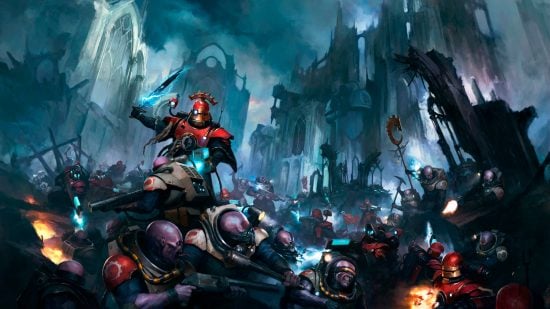
Humanity’s greatest enemies are the Warhammer 40k Chaos factions – and Chaos is what makes Warhammer 40k totally different from any other sci-fi setting. The 40k universe contains a parallel dimension, called the Warp, made up of psychic energy. The four Gods of Chaos, Nurgle, Tzeentch, Khorne, and Slaanesh, lurk in the Warp, eager to invade reality with their Daemon hordes.
Despite the terrible danger the Warp poses, the Imperium depends on it. The only way to travel between star systems is to jump through the Warp, where the laws of time and distance do not apply. Bold Rogue Traders seek out new worlds onboard ancient vessels the size of cities, every journey fraught with peril. The only way to communicate between worlds is through psychic messages projected by astro-telepaths.
For ten thousand years, the Imperium has hidden the reality of the Warp from its citizens, with organisations like the Inquisition and Grey Knights brutally suppressing the truth. But recent events have made that deception impossible.
The Imperial traitors who turned from the Emperor during the Horus Heresy fled into a realm where Warp and reality overlap, the Eye of Terror. Freed from the natural laws of time, those same Chaos renegades launch Black Crusades into Imperial space. The Thirteenth Black Crusade finally shattered the Imperium’s defences. Devastating Warp storms now split the galaxy in two.
Standing against the forces of Chaos are the innumerable human soldiers of the Astra Militarum, the holy Sisters of Battle, machine priests of the Adeptus Mechanicus, towering mechs piloted by the noble houses of Imperial Knights, and the mighty Space Marines, physically modified superhumans with genetic augmentations designed by the Emperor himself.
Great though the armies of the Imperium are, they are but a thin line against the hordes of Daemons, renegade Chaos Space Marines and traitorous Chaos Knights pouring from warp rifts throughout the galaxy – for in the grim darkness of the far future, there is only war.
Where to start in the Warhammer 40k story
There isn’t a perfect introduction to Warhammer 40k – remember, it started as a game, not a book or film. Entering the Warhammer 40k universe isn’t like watching the Star Wars movies in order.
Nonetheless, our guide recommending the best Warhammer 40k books is full of bangers, and any would be a great starting point.
The Warhammer 40k rulebook is a huge, coffee-table sized book – and less than half of it is rules. The rest is an encyclopaedia of the Warhammer 40k universe, complete with amazing illustrations and photographs of beautifully painted miniatures. If you like one faction in particular, the Warhammer 40k 9th edition Codex books go into detail on the lore for that faction.
Warhammer 40k: Chaos Gate Daemonhunters is a turn-based strategy game, and a stonking good one, earning a place on our list of the best games like XCOM. Controlling elite Grey Knights space marines, you fight back the vile forces of the Chaos plague God, Nurgle.
Warhammer 40k: Mechanicus is another, turn-based game with a brilliantly written story and superlative audio. It’s a great introduction to the post-human techpriests of the Mechanicus and the ancient, alien Necrons.
Warhammer 40k: Darktide is a FPS game in the 40k universe, light on direct narrative but extremely strong on ambience. The level design, chatter between your companions, and even the descriptions of items will immerse you into the world. It’s also a corking shooter in its own right.
The forces of Chaos breaking free of the Eye of Terror was a huge event in Warhammer 40k lore, and the Dawn of Fire novels follow the Imperium as it responded. They’re full of bombastic action, introduce all the major Imperial factions, and have plenty of Chaotic weirdness – and they’re still being written.
The Warhammer Crime stories focus on down-to-earth detective work that happens to be set in the Dark Millennium. The Imperium intentionally hides the truth of the galaxy from its citizens, including downtrodden gumshoes, so you can read these books without knowing anything about the setting as a whole. We’d recommend Bloodlines as a great first read.
The huge Horus Heresy series explores the most important event in the Imperium’s tragic history. This is a truly massive series with many strands, and we have a guide clarifying the Horus Heresy book order to help you navigate it.
Warhammer 40k game
Warhammer 40k is a tabletop wargame: two or more players take armies of miniatures, some rulebooks, tape measures, and a lot of dice, and fight a battle across a tabletop, which you probably jazz up with miniature terrain.
That’s the core of it. Of course, understanding how to play the game is a little more complicated than that, which is why we suggest you start with the Warhammer 40k starter set – it does a great job easing you in gently.
Many clubs of wargamers meet in game shops or in community venues to play Warhammer 40k and other tabletop wargames. These are a great way to meet other players, and most clubs will be happy to introduce a newcomer to the rules. Warhammer shops, the official Games Workshop retail outlet, offer demonstration games to newcomers.
Some people play Warhammer 40k competitively at tournaments, optimising their armies to be as effective as possible, and practising hard to ensure they achieve peak performance. But the majority of players are in it to relax, throw dice, and push their cool toy soldiers around a scale battlefield while occasionally saying “pew pew pew!”
Warhammer 40k uses about twenty to fifty models a side, depending on the army you play and the size of battle you want to fight. There are other wargames set in the Warhammer 40k universe. Warhammer 40k Kill Team focuses on close quarters combat between small squads, and uses around ten models a side. Necromunda is one for lovers of narrative, pitting handfuls of individually named, storied characters against one another in detailed campaigns.
Some games use a smaller scale of model to represent battles between much larger war-engines. Adeptus Titanicus is set during the Horus Heresy and charts the conflict between Warhammer Titans, walking robots with the armament of battleships. Aeronautica Imperialis uses airwings of wee aircraft for far future dogfights.
In short, there’s a game to suit every interest – and gaming tables of any size.

Painting miniatures
To play Warhammer 40k you need to have an army, which usually means building and painting miniatures yourself. For some gamers this is a chore, but for others this is a core part of the hobby, or even the only part that they’re interested in.
The skill ceiling for painting miniatures is incredibly high: Warhammer 40k publisher Games Workshop runs an annual competition, called Golden Demon, which attracts eye-popping miniatures from around the world. But even if you think you don’t have a creative bone in your body, you may be shocked how easy you find painting miniatures once you give it a try.
Warhammer 40k inspires some people to create their own, customised models, mixing parts from different model kits together to create “conversions”, or “scratch-building” new models out of modelling putty. Games Workshop makes scale scenery pieces for your battles, but building terrain from junk is a fun, crafty hobby that puts you in touch with your inner kid.
Cosplayers have a field-day with Warhammer 40k: it turns out that chunky, over-the-top, baroque armour that looks good on an inch-and-a-half tall model soldier looks incredible when a good cosplayer scales it up to human proportions.
Why we love Warhammer 40k
Warhammer 40k is one of the largest sci-fi franchises out there. That might seem daunting – how am I going to get to grips with it all? The truth is, you don’t have to. Warhammer 40k has something in it for everyone.
Warhammer 40k has hundreds of novels by dozens of authors starring a huge cast of characters from every faction – and now there’s even books for children. You can play it on the tabletop in self-contained board games, rock up to a game club and play a friendly game against chums, or follow the tournament scene and become a competitive 40k master. Building and painting miniatures is a hobby in itself, whether you do it to unwind, to let your creative juices flow, or because you’re chasing a coveted Golden Demon trophy.
Whatever becomes your favourite part of the hobby, the Wargamer team is wild about it too, so check back regularly – we’ll keep you up to date with everything in the world of Warhammer 40k.

